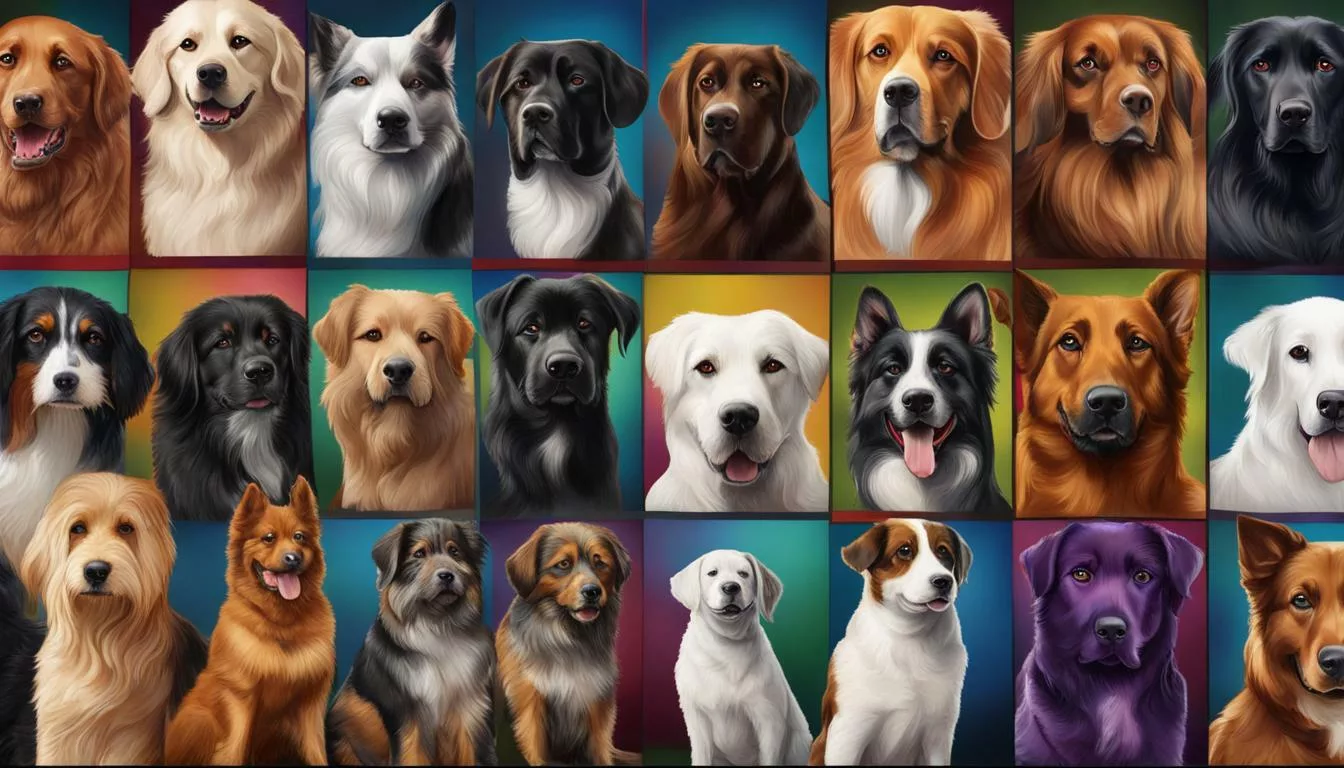Welcome to the exciting realm of dog breeds! Have you ever wondered just how many types of dogs there are in the world?
- The exact number of dog breeds in the world is difficult to determine due to variations and unrecognized breeds.
- The Fédération Cynologique Internationale (FCI) recognizes 339 breeds divided into 10 groups and numerous subgroups based on purpose or appearance.
- Various kennel clubs have different counts for recognized breeds, with the American Kennel Club recognizing 197 breeds and the Continental Kennel Club recognizing 187 breeds.
- There are designer dogs, which are mixed breeds, and some mixed breeds have become recognized as their own breeds in certain countries.
- One unique example is the Potcake Dog in Jamaica, a mixed breed that has gained recognition as its own breed.
The Fédération Cynologique Internationale (FCI) Registry
The Fédération Cynologique Internationale (FCI) plays a crucial role in documenting and categorizing dog breeds from around the globe. As the largest registry of internationally accepted dog breeds, the FCI provides valuable statistics on the worldwide variety of dog breeds.
According to the FCI, there are currently 339 recognized breeds divided into 10 groups. These groups are further classified into subgroups based on the purpose or appearance of the breeds. This comprehensive classification system allows for a better understanding of the diverse range of dog breeds that exist across the globe.
While the FCI is the primary authority on dog breed statistics, it’s important to note that different kennel clubs may have varying counts for recognized breeds. For instance, the American Kennel Club (AKC) recognizes 197 breeds, while the Continental Kennel Club (CKC) recognizes 187 breeds. The variations in recognized breeds highlight the unique perspectives and criteria used by different organizations.

The Fédération Cynologique Internationale (FCI) is dedicated to preserving and promoting the heritage and diversity of dog breeds worldwide. Their meticulous documentation and categorization ensure that each breed is recognized and appreciated for its unique characteristics and contributions to the canine world.
It’s worth mentioning that the FCI’s registry is not exhaustive, as there may still be unrecognized or developing breeds that have yet to gain official recognition. Additionally, the concept of designer dogs, which are mixed breeds intentionally created by crossbreeding two purebred dogs, adds another layer of complexity to the count of dog breeds worldwide.
In some cases, mixed breeds have even become recognized as their own breeds in certain countries. For example, the Potcake Dog, native to the Caribbean, has gained recognition as a distinct breed in Jamaica. These unique cases demonstrate the adaptability and evolution of dog breeds, allowing for greater recognition of their diverse heritage.
In conclusion, while the exact number of dog breeds in the world may be difficult to ascertain, the Fédération Cynologique Internationale (FCI) provides valuable insight into the global canine landscape. Their registry, along with the recognition of breeds by different kennel clubs and the emergence of designer and mixed breeds, contributes to the rich tapestry of dog breeds that exist today.
The Classification System of Dog Breeds
To better understand the variety of dog breeds, it’s important to explore the classification system used to categorize them. Dog breeds are classified based on their characteristics, purpose, and appearance. This system helps organize the vast number of breeds into manageable groups, making it easier for enthusiasts and researchers to study and understand the different types of dogs.
The Fédération Cynologique Internationale (FCI), the largest registry of internationally accepted dog breeds, divides the breeds into 10 groups. These groups are:
- Sheepdogs and Cattle Dogs
- Pinschers and Schnauzers, Molossoids, and Swiss Mountain and Cattle Dogs
- Terriers
- Dachshunds
- Spitz and Primitive Types
- Scenthounds and Related Breeds
- Pointing Dogs
- Retrievers, Flushing Dogs, and Water Dogs
- Companion and Toy Dogs
- Sighthounds
Each group is further divided into subgroups, which may be based on the breed’s purpose or appearance. This classification system helps highlight the unique traits and characteristics of each breed, allowing breeders and owners to better understand their dog’s heritage and potential traits.
To get a visual understanding of the classification system, here is a table showcasing the 10 groups of dog breeds:
| Group | Subgroup |
|---|---|
| Sheepdogs and Cattle Dogs | Sheepdogs |
| Cattledogs (except Swiss Cattledogs) | |
| Swiss Cattledogs | |
| Pinschers and Schnauzers, Molossoids, and Swiss Mountain and Cattle Dogs | Pinschers and Schnauzers |
| Molossoids | |
| Terriers | – |
| Dachshunds | – |
| Spitz and Primitive Types | Spitz |
| Nordic Hunting Dogs | |
| Primitive Types | |
| Primitive Type – Hunting Dogs | |
| Scenthounds and Related Breeds | Scenthounds |
| Leash (Scent) Hounds | |
| Related Breeds | |
| Pointing Dogs | Continental Pointing Dogs |
| British and Irish Pointers and Setters | |
| Setters – British and Irish | |
| Spaniels – English Springer and Welsh | |
| Retrievers, Flushing Dogs, and Water Dogs | Retrievers |
| Flushing Dogs | |
| Water Dogs | |
| Companion and Toy Dogs | – |
| Sighthounds | – |
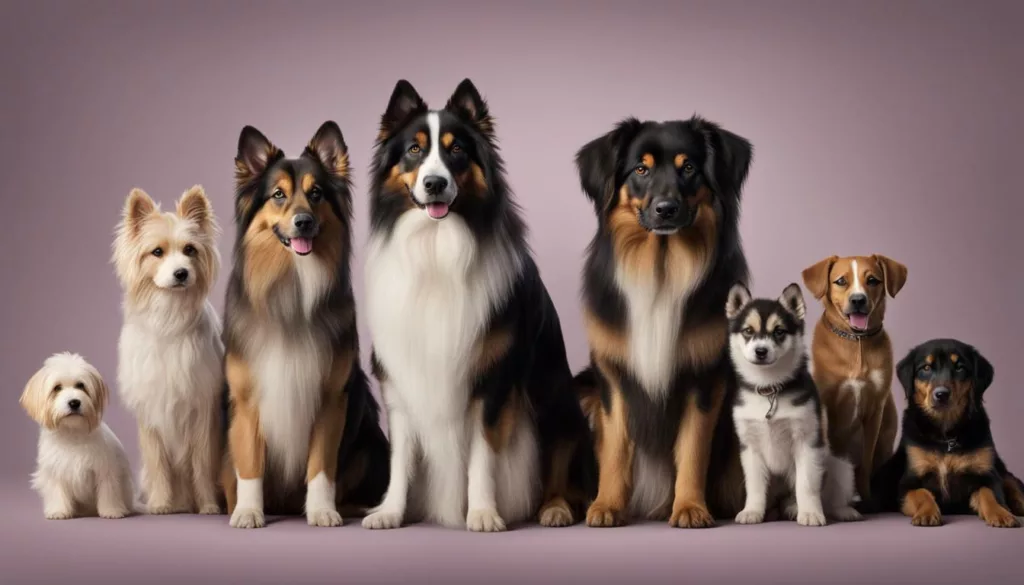
To fully appreciate the range and diversity of dog breeds, it’s essential to delve into the classification system. This system helps us understand the various groups and subgroups that make up the vast array of dog breeds worldwide. By studying the classification system, we can gain insight into the heritage, purpose, and appearance of different breeds. So, whether it’s a herding dog, a companion breed, or a sporting dog, understanding the classification system allows us to appreciate the unique traits and characteristics that make each breed special.
To summarize, the classification system of dog breeds divides them into 10 groups based on their characteristics, purpose, and appearance. Each of these groups is further divided into subgroups, allowing for a more detailed categorization. This system is crucial for breeders, enthusiasts, and researchers, as it provides a structured approach to understanding and studying the vast number of dog breeds worldwide.
By exploring the classification system, we gain a deeper appreciation for the incredible diversity within the world of dog breeds. From the herding dogs that diligently work alongside their human counterparts to the playful toy breeds that provide companionship and joy, each breed has its own unique traits and contributions. Understanding the classification system brings us one step closer to fully embracing and celebrating the magic of dog breeds.
The Ten Groups of Dog Breeds
Dog breeds encompass a wide array of sizes, temperaments, and purposes, and the Fédération Cynologique Internationale (FCI) groups them into ten distinct categories. These groups help organize and classify breeds based on their shared characteristics and functions. Let’s explore each group and the diverse breeds within them.
Group 1: Sheepdogs and Cattle Dogs
This group includes breeds such as the Border Collie, German Shepherd, and Australian Cattle Dog. Known for their herding abilities, these dogs are highly intelligent, agile, and excel in tasks requiring control over livestock.
Group 2: Terriers
Terriers are known for their spirited nature and determination, making them excellent vermin hunters. Popular breeds in this group include the Scottish Terrier, Jack Russell Terrier, and Bull Terrier.
Group 3: Scenthounds and Related Breeds
This group consists of breeds with exceptional scenting abilities, often used for tracking and hunting game. It includes breeds like the Bloodhound, Basset Hound, and Beagle.
Group 4: Dachshunds
Dachshunds, or “sausage dogs,” are long-bodied and short-legged hounds. They were originally bred for hunting badgers and small game. Varieties include the Standard, Miniature, and Toy Dachshunds.
Group 5: Spitz and Primitive Types
This group includes breeds with wolf-like features and characteristics, such as the Siberian Husky, Alaskan Malamute, and Shiba Inu. These dogs are known for their endurance, strength, and independent nature.
Group 6: Scent and Sight Hounds
In this group, you’ll find breeds with exceptional sight or scenting abilities, used for hunting game by either sight or scent. Popular breeds include the Greyhound, Afghan Hound, and Whippet.
Group 7: Pointing Dogs
Pointing dogs are skilled at finding and pointing at game birds, signaling their location to hunters. Popular breeds in this group include the German Shorthaired Pointer, English Setter, and Brittany Spaniel.
Group 8: Retrievers, Flushing Dogs, and Water Dogs
Known for their ability to retrieve game from land or water, this group includes the Labrador Retriever, Golden Retriever, and Irish Water Spaniel. These breeds are intelligent, loyal, and excel in field and water-related activities.
Group 9: Companion and Toy Dogs
Companion and Toy Dogs are bred primarily for their companionship and small size. Breeds in this group include the Pomeranian, Chihuahua, and Shih Tzu. They are often adored for their affectionate and sociable nature.
Group 10: Sighthounds
Sighthounds are known for their incredible speed and agility, making them supremely talented at chasing and capturing game by sight. Popular breeds in this group include the Greyhound, Saluki, and Whippet.
Each group within the FCI classification system provides a unique perspective on the incredible diversity of dog breeds worldwide. From herding to hunting, companionship to competition, there’s a breed for every purpose and lifestyle.
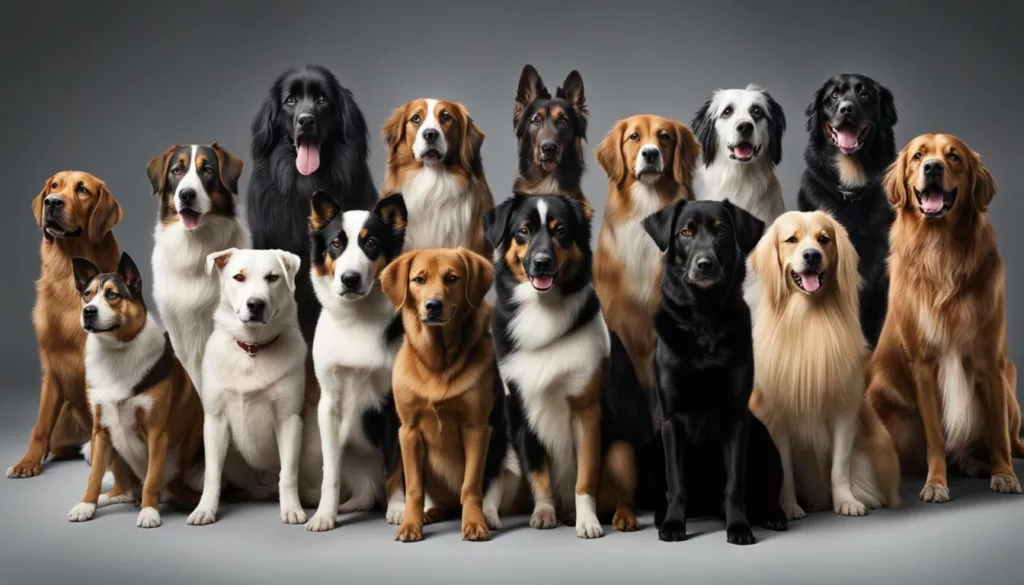
| Group | Examples of Breeds |
|---|---|
| 1. Sheepdogs and Cattle Dogs | Border Collie, German Shepherd, Australian Cattle Dog |
| 2. Terriers | Scottish Terrier, Jack Russell Terrier, Bull Terrier |
| 3. Scenthounds and Related Breeds | Bloodhound, Basset Hound, Beagle |
| 4. Dachshunds | Standard Dachshund, Miniature Dachshund, Toy Dachshund |
| 5. Spitz and Primitive Types | Siberian Husky, Alaskan Malamute, Shiba Inu |
| 6. Scent and Sight Hounds | Greyhound, Afghan Hound, Whippet |
| 7. Pointing Dogs | German Shorthaired Pointer, English Setter, Brittany Spaniel |
| 8. Retrievers, Flushing Dogs, and Water Dogs | Labrador Retriever, Golden Retriever, Irish Water Spaniel |
| 9. Companion and Toy Dogs | Pomeranian, Chihuahua, Shih Tzu |
| 10. Sighthounds | Greyhound, Saluki, Whippet |
Recognized Breeds by Different Kennel Clubs
While the FCI is the largest international registry, other kennel clubs also play a significant role in recognizing and registering dog breeds. The American Kennel Club (AKC) is one of the most well-known kennel clubs in the United States and officially recognizes 197 breeds. The AKC has a rigorous process for breed recognition, which includes meeting specific criteria in terms of breed characteristics, breed population, and geographic distribution.
The Continental Kennel Club (CKC) is another prominent organization when it comes to recognizing and registering dog breeds. The CKC recognizes 187 breeds, many of which are also recognized by the AKC and the FCI. Similar to the AKC, the CKC has a thorough evaluation process to ensure breed standards are met before recognition is granted.
Here is a table summarizing the number of recognized breeds by these kennel clubs:
| Kennel Club | Number of Recognized Breeds |
|---|---|
| American Kennel Club (AKC) | 197 |
| Continental Kennel Club (CKC) | 187 |
| Fédération Cynologique Internationale (FCI) | 354 |
In addition to these recognized breeds, there are also designer dogs, which are mixed breed dogs intentionally crossbred to create specific traits. These designer dogs come in various combinations and have gained popularity in recent years. While they may not be officially recognized by kennel clubs, they have their own following and devoted enthusiasts.
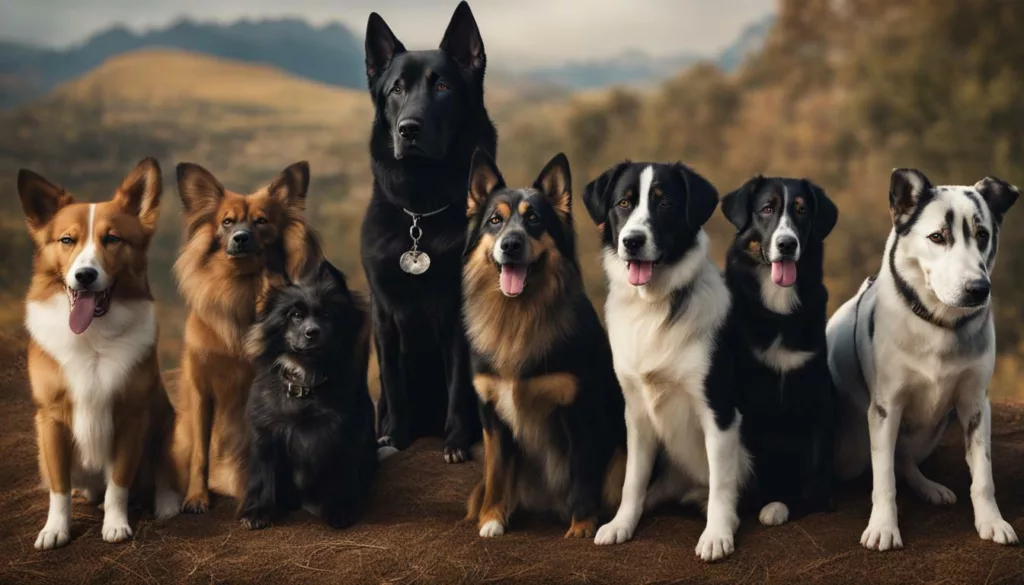
The world of dog breeds is a magnificent tapestry of diversity and companionship. While the exact number of breeds may be difficult to determine, the FCI and various kennel clubs help maintain records and standards for recognized breeds. Whether it’s the recognized breeds, designer dogs, or mixed breeds, each dog brings its unique qualities and enriches our lives in different ways.
The American Kennel Club (AKC)
In the United States, the American Kennel Club (AKC) serves as a prominent authority on dog breeds and breed standards. With a rich history dating back to 1884, the AKC has played a vital role in documenting and preserving the integrity of purebred dog breeds.
The AKC officially recognizes 197 breeds, each classified into one of seven groups: Herding, Hound, Non-Sporting, Sporting, Terrier, Toy, and Working. Each breed within these groups possesses unique characteristics, temperament, and physical attributes that define its role and purpose.
As an organization dedicated to the welfare and enhancement of purebred dogs, the AKC sets strict breed standards that dictate the ideal size, coat, color, and overall appearance for each recognized breed. These standards ensure consistency and quality within the breed, maintaining its heritage and preserving its distinct characteristics.
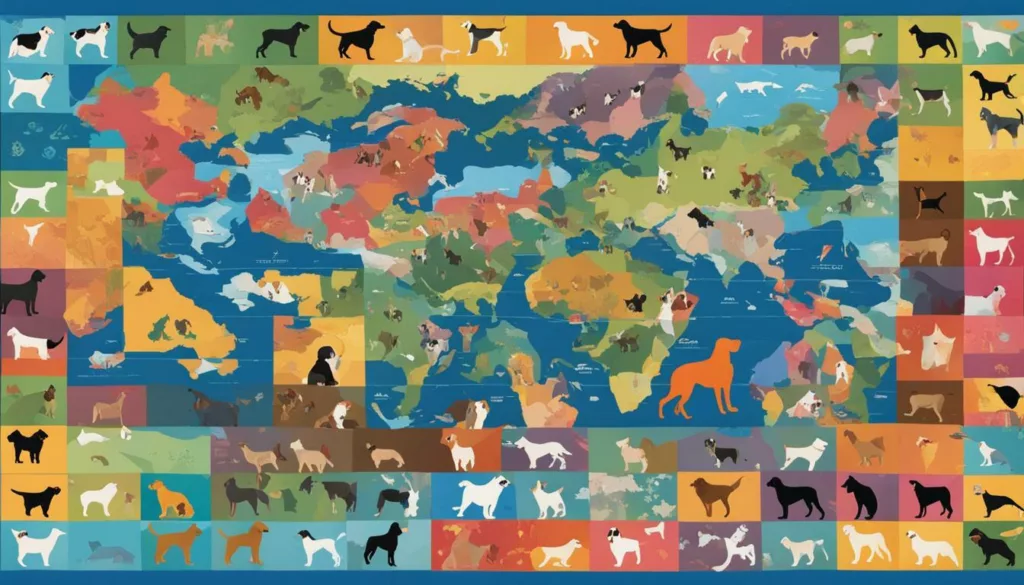
The AKC also hosts numerous events and activities, including dog shows, obedience trials, and performance events, where dog enthusiasts gather to showcase the beauty, skill, and exceptional qualities of various breeds. Through their efforts, the AKC promotes responsible dog ownership, education, and the understanding of different breeds.
The Continental Kennel Club (CKC)
Alongside the AKC, the Continental Kennel Club (CKC) also plays a vital role in documenting and recognizing dog breeds. While the CKC may not be as widely known as the AKC, it is still a significant organization in the world of dog breeds. The CKC has documented and recognized a total of 187 breeds, contributing to the diverse canine landscape.
The CKC’s commitment to breed recognition ensures that a wide variety of breeds are acknowledged and celebrated. From popular breeds to lesser-known ones, the CKC strives to provide comprehensive documentation and registration for dog owners and enthusiasts.
In addition to breed recognition, the CKC promotes responsible dog ownership and encourages ethical breeding practices. The organization provides resources and support to breeders, ensuring that the welfare and health of the dogs are prioritized.
With their dedication to breed documentation and responsible ownership, the CKC contributes to the global understanding and appreciation of dog breeds. Their efforts help maintain the diversity of the canine world and ensure that each breed receives the recognition it deserves.
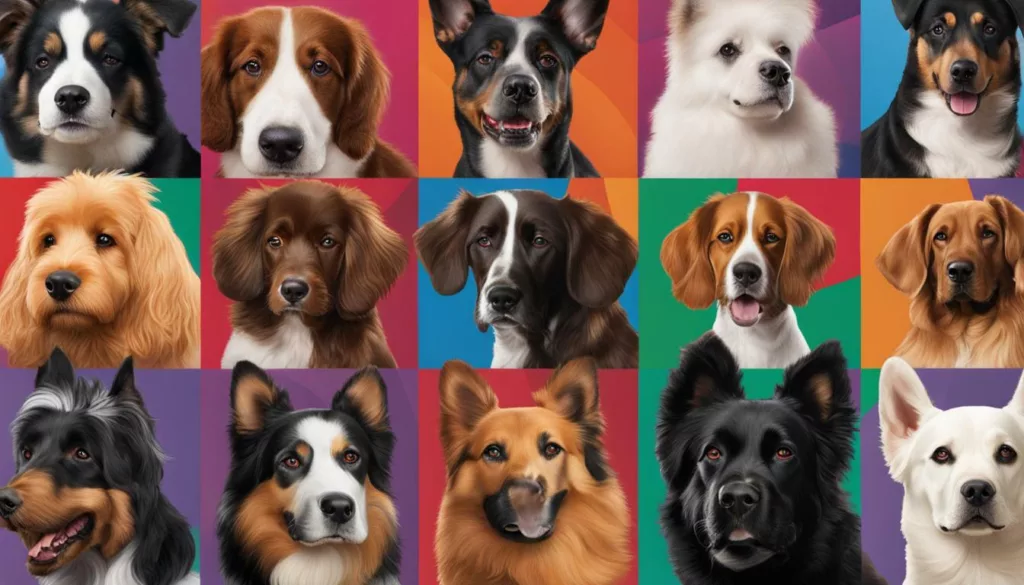
To provide a closer look at the dog breeds recognized by the CKC, here is a table highlighting some examples:
| Breed | Group | Size | Origin |
|---|---|---|---|
| Labrador Retriever | Sporting | Large | Canada |
| Chihuahua | Toy | Small | Mexico |
| Bulldog | Non-Sporting | Medium | England |
| Rottweiler | Working | Large | Germany |
The Designer Dogs
In recent years, the emergence of designer dogs has added to the diversity of dog breeds around the world. Designer dogs are mixed breeds that are intentionally created by crossbreeding two different purebred dogs. This practice has gained popularity among dog lovers who are seeking a unique and customized pet that combines the best traits of two breeds.
Designer dogs often have creative names that reflect their parentage, such as Labradoodle (Labrador Retriever + Poodle) and Cockapoo (Cocker Spaniel + Poodle). These hybrid dogs can have a wide range of physical characteristics and temperaments, making them a popular choice for families with specific preferences or requirements.
While designer dogs are not recognized as official breeds by organizations like the Fédération Cynologique Internationale (FCI) or some kennel clubs, they have undeniably contributed to the global dog breed count. Their unique combination of traits and the growing demand for them have led to an increase in the variety of dog breeds available worldwide.

To better understand the diversity of designer dogs, let’s take a look at a small selection of some popular and unique hybrid breeds:
| Designer Dog Breed | Parent Breeds | Physical Characteristics | Temperament |
|---|---|---|---|
| Goldendoodle | Golden Retriever + Poodle | Curly or wavy coat, medium to large size | Intelligent, friendly, and affectionate |
| Cavapoo | Cavalier King Charles Spaniel + Poodle | Soft, wavy coat, small to medium size | Gentle, sociable, and playful |
| Puggle | Pug + Beagle | Short coat, small size | Energetic, friendly, and sociable |
These are just a few examples of the numerous designer dog breeds that exist today. Each breed offers a unique combination of characteristics, allowing dog enthusiasts to find the perfect companion that suits their lifestyle and preferences. The popularity of designer dogs continues to grow as more people discover the joy of owning a one-of-a-kind canine companion.
Mixed Breeds Becoming Recognized Breeds
It’s interesting to note that certain mixed breed dogs have achieved official recognition as distinct breeds in specific regions. This phenomenon highlights the dynamic nature of breed development and the role that mixed breeds play in expanding the diversity of dog breeds worldwide.
One notable example is the Potcake Dog of the Caribbean. This mixed breed, which originated from the islands of the Bahamas, Turks and Caicos, and the Cayman Islands, has gained recognition as a breed in its own right. Potcake Dogs are known for their friendly and affectionate nature, making them popular pets in the Caribbean and beyond.
To showcase the uniqueness of the Potcake Dog, here is an image of this beautiful breed:

In addition to the Potcake Dog, there are other mixed breeds that have achieved recognition as distinct breeds in certain countries. These dogs often possess a combination of desirable traits from their parent breeds, making them sought after by dog enthusiasts and breeders.
The recognition of mixed breeds as legitimate breeds is a testament to the ever-evolving nature of dog breeding and the constant pursuit of creating new breeds that meet the diverse needs of dog lovers all over the world.
Unique Cases: The Potcake Dog
The Potcake Dog in Jamaica serves as a remarkable example of a mixed breed dog that has gained recognition and appreciation within its native country. This dog is affectionately named after the traditional Caribbean dish made from leftover food scraps, as it was commonly fed these scraps by locals. The Potcake Dog is known for its resilience and adaptability, making it a beloved companion and a symbol of Jamaican culture.
Despite its mixed breed heritage, the Potcake Dog has become an officially recognized breed in Jamaica. This recognition is a testament to the dog’s unique characteristics and its significant contribution to the country’s history and culture. These dogs are known for their intelligence, loyalty, and friendly nature, making them excellent family pets.
The Potcake Dog’s recognition as a breed in Jamaica demonstrates the global dog breed diversity and the significance of local breeds in different regions. While it is not officially recognized by international kennel clubs, the Potcake Dog’s popularity and distinctive traits have gained attention and admiration beyond the borders of Jamaica.
As we celebrate the diversity of dog breeds around the world, it’s important to recognize unique cases like the Potcake Dog. They remind us of the rich cultural connections between humans and their furry companions, and the profound impact that mixed breeds can have on our lives.

The Potcake Dog’s origin and development can be traced back to the various dog breeds that arrived in the Caribbean with European colonizers. Over time, these dogs interbred, resulting in a mixed breed with a distinct and endearing personality. Their name, Potcake, represents their resourcefulness and ability to thrive on the scraps that remain in cooking pots.
These dogs have become an integral part of Jamaican society, cherished for their ability to adapt to the local environment and form deep bonds with their human companions. While they may not have a standardized appearance or set breed characteristics, their diversity and resilience make them an important part of the global dog breed varieties.
| Breed Name | Recognition |
|---|---|
| Potcake Dog | Recognized in Jamaica, not recognized internationally |
The recognition of the Potcake Dog within Jamaica highlights the importance of preserving and celebrating local breeds. These dogs bring joy, companionship, and a unique piece of Jamaican culture to their owners. Whether recognized internationally or not, the Potcake Dog remains a cherished part of the global dog breed diversity.
Exploring the Numbers
Armed with the knowledge we’ve acquired, it’s time to delve into the diverse range of dog breeds around the world. While the exact number of dog breeds can be difficult to determine, the Fédération Cynologique Internationale (FCI), the largest registry of internationally accepted breeds, documents 339 breeds divided into 10 groups. Each group is further categorized into subgroups based on the purpose or appearance of each breed.
However, different kennel clubs may recognize varying numbers of breeds. The American Kennel Club (AKC), one of the prominent kennel clubs in the United States, officially recognizes 197 breeds. On the other hand, the Continental Kennel Club (CKC) acknowledges 187 breeds. The FCI, encompassing a global perspective, recognizes 354 breeds. This variation in counts highlights the different criteria and perspectives of each organization.
In addition to purebred breeds, there are designer dogs, which are mixed breeds intentionally created by crossbreeding two different purebred dogs. These designer dogs contribute to the overall count of dog breeds worldwide, adding to the diversity and choices available to dog lovers.
It’s worth noting that some mixed breeds have even become recognized as their own breeds in certain countries. For instance, the Potcake Dog, a mixed breed native to the Caribbean, has gained recognition as a distinct breed in its own right. This unique case exemplifies the evolving nature of breed recognition and the fascinating stories behind some dog breeds.
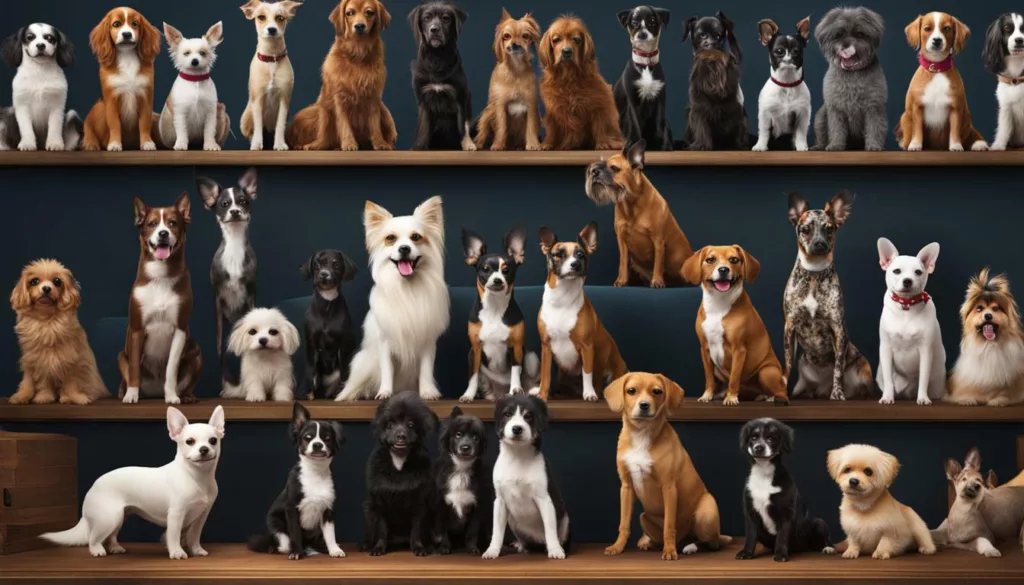
- The FCI documents 339 dog breeds worldwide, divided into 10 groups and further categorized into subgroups based on purpose or appearance.
- The AKC officially recognizes 197 breeds, while the CKC acknowledges 187 breeds. The FCI recognizes 354 breeds.
- Designer dogs, mixed breeds intentionally created by crossbreeding, contribute to the variety of dog breeds globally.
- Some mixed breeds have become recognized as their own breeds in certain countries, such as the Potcake Dog in the Caribbean.
With such a wide array of dog breeds to choose from, there is a perfect companion for every dog lover. Whether you prefer purebred breeds or the charm of mixed breeds, the world of dog breeds never ceases to amaze with its endless variety and unique stories.
| Organization | Number of Recognized Breeds |
|---|---|
| American Kennel Club (AKC) | 197 |
| Continental Kennel Club (CKC) | 187 |
| Fédération Cynologique Internationale (FCI) | 354 |
Considering Variations and Unrecognized Breeds
While there is a general consensus on the number of recognized breeds, it’s worth considering the wide array of popular, rare, large, and small dog breeds that may not fit into the official count. These breeds often have unique characteristics and can be beloved by many dog enthusiasts.
Popular dog breeds, such as the Labrador Retriever, Golden Retriever, and German Shepherd, consistently rank high in popularity due to their friendly dispositions, trainability, and versatility. These breeds are known for their loyalty and make excellent family pets. On the other hand, rare dog breeds like the Azawakh, Tibetan Mastiff, and Xoloitzcuintli capture the hearts of those seeking something more unique and uncommon. These breeds often have fascinating histories and captivating appearances that set them apart.
When it comes to size, the world of dog breeds offers a diverse range. From the towering Great Dane and Saint Bernard, which are counted among the largest dog breeds, to the petite Chihuahua and Yorkshire Terrier, which are among the smallest, dog lovers can find a breed to suit their preferences. Each size category has its own charm and appeal, with large breeds often known for their gentle nature and small breeds cherished for their compact size and adorable features.
| Category | Example Breeds |
|---|---|
| Popular Dog Breeds | Labrador Retriever, German Shepherd, Golden Retriever |
| Rare Dog Breeds | Azawakh, Tibetan Mastiff, Xoloitzcuintli |
| Largest Dog Breeds | Great Dane, Saint Bernard, Irish Wolfhound |
| Smallest Dog Breeds | Chihuahua, Yorkshire Terrier, Pomeranian |
“The more I learn about people, the more I love my dog.” – Mark Twain
While the official count of recognized breeds provides a comprehensive overview of the distinct breeds within the dog world, it’s important to appreciate and celebrate the countless variations and unrecognized breeds that exist alongside them. These often overlooked breeds add richness and diversity to the already fascinating tapestry of dog breeds worldwide.
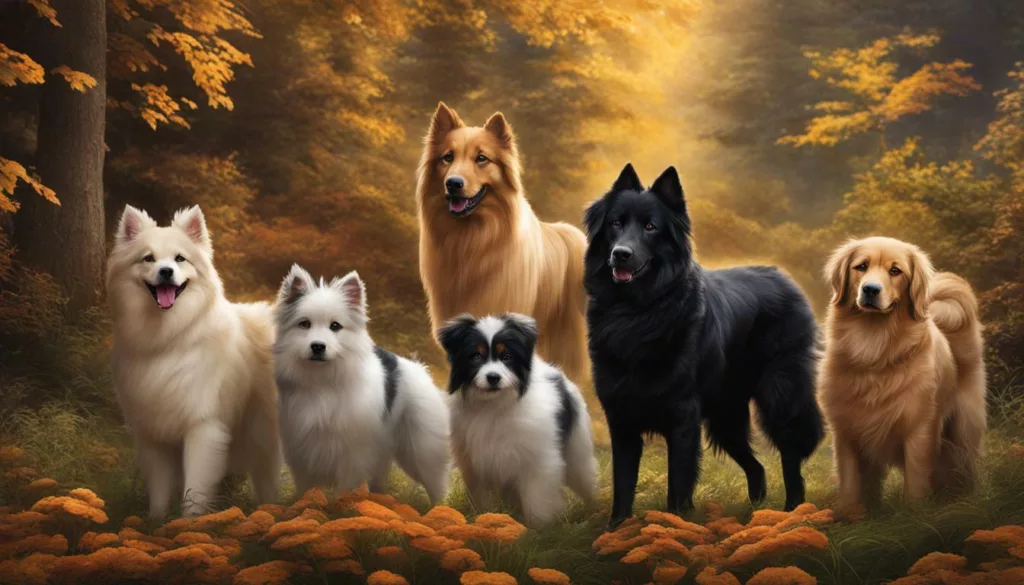
The world of dog breeds is a magical place, with each breed offering its own set of characteristics, temperament, and love. From the loyal and protective German Shepherd to the playful and energetic Labrador Retriever, there is a breed for every type of person and lifestyle. But just how many dog breeds are there in the world?
According to the Fédération Cynologique Internationale (FCI), the largest registry of internationally accepted dog breeds, there are 339 breeds divided into 10 groups. These groups, such as the Herding group, Sporting group, and Toy group, encompass breeds that share similar characteristics and purposes.
But the numbers don’t stop there. Different kennel clubs, such as the American Kennel Club (AKC) and the Continental Kennel Club (CKC), also recognize and register breeds. The AKC, for example, recognizes 197 breeds, while the CKC recognizes 187 breeds. The FCI, which oversees dog breeds globally, recognizes a staggering 354 breeds.
It’s not just purebred dogs that make up the world of dog breeds. Designer dogs, which are mixed breeds intentionally crossbred for specific traits, have become increasingly popular. Additionally, some mixed breeds have even gained recognition as their own breeds in certain countries. One such example is the Potcake Dog, a mixed breed native to the Caribbean that has become recognized as a breed in its own right.
With such a diverse range of breeds to choose from, it’s no wonder that dogs hold a special place in our hearts. Whether you’re looking for a small and cuddly companion or a larger, more active breed, there’s a dog out there for everyone. The world of dog breeds truly is a wonder to behold.
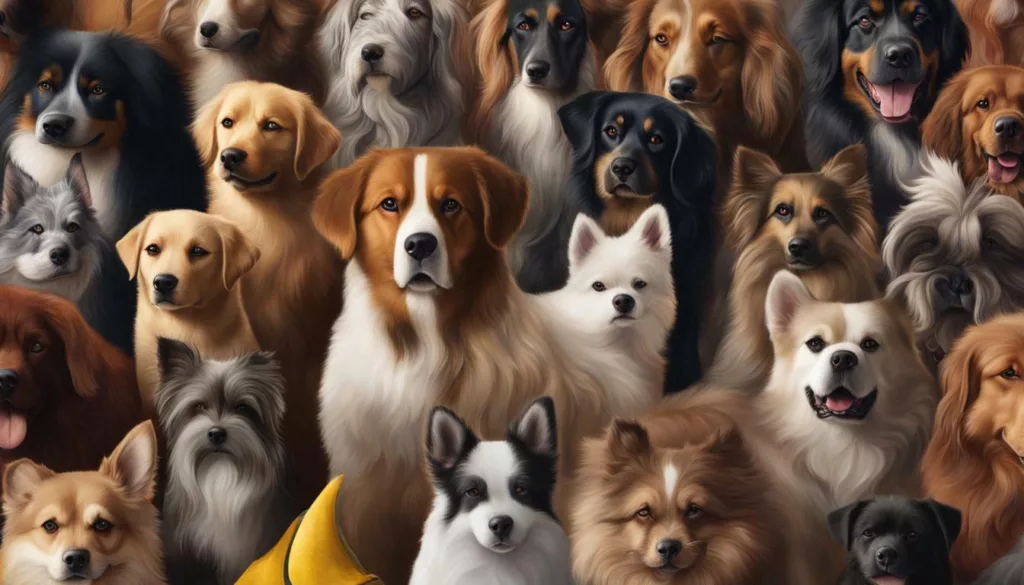
| Kennel Club | Number of Recognized Breeds |
|---|---|
| American Kennel Club (AKC) | 197 |
| Continental Kennel Club (CKC) | 187 |
| Fédération Cynologique Internationale (FCI) | 354 |
Wrapping Up – The Incomparable World of Dog Breeds
In conclusion, the world of dog breeds encompasses an astonishing range of species, each with its own set of unique traits, making them a beloved part of our lives.
Discovering the exact number of dog breeds in the world can be difficult due to variations and unrecognized breeds. However, according to the Fédération Cynologique Internationale (FCI), the largest registry of internationally accepted dog breeds, there are 339 breeds divided into 10 groups. Each group is further divided into subgroups based on the breed’s purpose or appearance.
Meanwhile, different kennel clubs have varying counts for recognized breeds, with the American Kennel Club recognizing 197 breeds, the Continental Kennel Club recognizing 187 breeds, and the FCI recognizing 354 breeds. Additionally, there are designer dogs, which are mixed breed dogs, and some mixed breeds have even become recognized as their own breeds in certain countries, such as the Potcake Dog in Jamaica.
In summary, while the exact count of dog breeds may vary, it is undeniable that the world of dog breeds is a wonder to behold. From the loyal German Shepherds to the playful Dalmatians, each breed brings its own unique characteristics and companionship to our lives. So, whether you prefer a small, energetic breed or a large, gentle giant, there is a dog out there for everyone. Let’s celebrate the diversity and magic of dog breeds and continue to cherish these incredible animals.
FAQ
How many recognized dog breeds are there in the world?
The exact number of recognized dog breeds can vary depending on the kennel club or registry. According to the Fédération Cynologique Internationale (FCI), there are 354 recognized breeds worldwide. However, the American Kennel Club (AKC) officially recognizes 197 breeds, and the Continental Kennel Club (CKC) recognizes 187 breeds.
How are dog breeds classified?
Dog breeds are classified based on their characteristics, purpose, and appearance. The FCI divides breeds into ten groups, such as sporting dogs, herding dogs, and toy dogs. Each group is further divided into subgroups based on specific traits.
Are designer dogs considered as separate breeds?
Designer dogs are mixed breed dogs created by intentionally crossbreeding two different purebred dogs. While they are not recognized as official breeds by most kennel clubs, they have gained popularity in recent years. Examples of designer dogs include Labradoodles (Labrador Retriever and Poodle mix) and Goldendoodles (Golden Retriever and Poodle mix).
Can mixed breeds become recognized as their own breeds?
In some cases, certain mixed breeds have become recognized as their own breeds in specific countries. An example of this is the Potcake Dog, which is a mixed breed native to Jamaica that has gained recognition as a distinct breed due to its cultural significance.
Why do the numbers of recognized breeds vary among kennel clubs?
Different kennel clubs have their own criteria for recognizing breeds, which can result in variations in the number of recognized breeds. Additionally, some kennel clubs may have specific requirements or standards for breed recognition that are not met by certain breeds.
Are there any unofficial or unrecognized dog breeds?
Yes, there are variations and unrecognized breeds that exist outside of official registries. These breeds may have unique characteristics or be specific to certain regions or communities. It is important to note that the number of these breeds is not easily quantified or standardized.
Hi, I’m John and I love dogs. Ever since I was a kid, I always wanted to have a furry friend by my side. I grew up with a golden retriever named Max, who taught me a lot about loyalty, friendship, and fun. He was my best buddy for 12 years, and I miss him every day.
